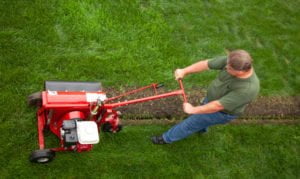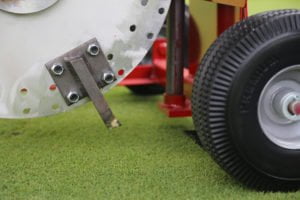How to Use a Kwik-Trench for DIY Projects
If you have a project that requires shallow trenching such as installing electric dog fencing, landscape edging or lawn sprinkler systems, you might be trying to determine the fastest way to dig a trench. Instead of using manual methods like drainage spades and trenching hoes, renting a mini-trencher like Little Beaver’s Kwik-Trench is an option to make do-it-yourself (DIY) trenching quicker and easier than ever. But before you make a trip to your nearest rental center, there are a few things to know about trenchers.

What is a Trencher?
A trencher is a type of earth-moving equipment that uses a metal chain or a wheel with steel teeth to rip into the ground. Trenchers come in a variety of sizes and models for applications ranging from installing electrical cables and drainage to landscape projects around the house.
Types of Landscape Trenchers
The trenchers used for landscaping are very different than the trenchers that are used for farming or utility trenching. While there are trencher attachments that can be combined with large machines or ride-on trenchers, there is also a whole class of landscaping trenchers which are perfect for DIY yard projects. These compact trenchers maximize features such as maneuverability and versatility. When reviewing the different types of landscape trenchers, it’s important to understand what each option offers so you can select the best trencher for the job.
Handheld Trenchers
These types of trenchers look like a chainsaw and can trench up to 16 to 27 inches deep, which makes them great for deeper landscaping projects. Renting a handheld trencher is less labor-intensive than using different types of shovels and spades involved in manual methods. However, safety can be a concern with handheld trenchers as well. When a handheld trencher hits a rock, the kickback can cause serious injury to the operator if their hand slips. Additionally, flying debris from the spinning blade can cause injuries if proper safety equipment is not worn.
Walk-Behind Trenchers
Walk-behind landscape trenchers make the job easier than using handheld trenchers. Instead of straining your back with a handheld trencher, walk-behind trenchers allow the operator to stand while trenching and guide the trencher as it does the work. If you choose to go this route, here’s what to look for.
Choose a trencher you feel comfortable operating. Unlike the name implies, most walk-behind trenchers require the operator to slowly walk backwards as the trencher digs, but the backward pulling movement is so slow it appears that the operator is “walking behind” the machine. If walking backward while trenching seems like a safety risk because you can’t see what’s in your way, there are other options available that maximize convenience and safety. For example, the Kwik-Trench mini-trencher from Little Beaver is a revolutionary walk-behind trencher with a simple, push forward design that makes it one of the safest, fastest and easiest to use trenchers on the market. In fact, it can reach cutting speeds of up to 30 feet per minute.
 Maneuverability is also an important factor to consider with landscape trenching machines. Look for a mini-trencher with compact construction for maneuvering around obstacles like landscape settings, fences, gates and vegetation. To make the clean-up process easier, we suggest getting a mini-trencher with pneumatic tires to easily glide over grass without ripping it up. Some mini-trenchers like our Kwik-Trench are also designed to neatly deposit soil next to the trench for neat, easy backfilling.
Maneuverability is also an important factor to consider with landscape trenching machines. Look for a mini-trencher with compact construction for maneuvering around obstacles like landscape settings, fences, gates and vegetation. To make the clean-up process easier, we suggest getting a mini-trencher with pneumatic tires to easily glide over grass without ripping it up. Some mini-trenchers like our Kwik-Trench are also designed to neatly deposit soil next to the trench for neat, easy backfilling.
Choosing Your Trencher
For more information about the Kwik-Trench, check out our blog on Kwik-Trench Do’s and Don’ts. Otherwise, if any additional questions come up as you’re researching mini-trenchers, don’t hesitate to contact Little Beaver or your local rental center for tips and ideas. We want your DIY project to go as smoothly as possible and are happy to offer any advice on the equipment you need to make it happen.